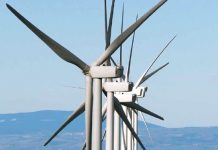Siemens Gamesa Renewable Energy has officially inaugurated its nacelle plant in Cuxhaven, Germany, at a ceremony attended by the German Federal Minister of Economics and Energy Peter Altmaier together with additional politicians and members of the company’s board. At this ultra-modern production facility, Siemens Gamesa assembles the nacelles for wind turbines used at sea.
The processes in the plant, as well as the transport to the marine wind-power plants, are particularly efficient in order to further reduce the costs of electricity generated on the open water.
This plant is the largest production facility of its kind in Germany. With a total investment of about 200 million euros, the Cuxhaven factory is expected to employ about 850 people in and at the Cuxhaven plant by the end of this year. More than half of these employees will work directly in manufacturing.
Construction work on the 55,000-square-meter factory began in June 2016, and production has been underway since mid-2017.

“With our new plant in Cuxhaven, Siemens Gamesa is sending a clear signal regarding the power of renewable energy,” said Markus Tacke, CEO of Siemens Gamesa Renewable Energy. “Numerous innovations continue to make offshore wind power even more competitive with other sources of industrial power generation. Lowering the levelized cost of energy from offshore wind is a key focus area for us, benefiting our customers, ratepayers, and society-at- large. Today, I would like to thank our energetic employees here in Cuxhaven and in the company for their untiring commitment. We would also like to thank the numerous supporters of the project in politics and at Siemens AG as well as our committed partners.”
The new Siemens Gamesa offshore nacelle factory is built in close proximity to the edge of the Germany North Sea port, allowing the direct transport of large and heavy wind-turbine components by ship from the plant to wind-power plants at sea. The specially-built transport ship Rotra Vente is an elementary component of the Ro/Ro (Roll on/Roll off) logistics concept developed by Siemens Gamesa. Compared with conventional road transport and crane loading, the Ro/Ro significantly increases safety and saves about 20 percent of logistics costs.
The production processes in the 32-meter-high factory building are also trimmed for efficiency. A digital material flow control ensures short service life and availability of all components in the correct sequence. Modern industrial robots equip the generators with magnets and thus ensure optimum product quality. Digital systems are used in numerous test processes and to document the individual production steps.
“With its new plant, Siemens Gamesa is impressively demonstrating that offshore wind energy has developed into a powerful and competitive industry,” said Federal Minister of Economics and Energy Peter Altmaier, who had sent State Secretary Enak Ferlemann to the inauguration ceremony due to short-term appointments. “From a niche product of the 1990s, an industry has emerged that has become an important part of German machine building sector.”
“I’m excited to see what Siemens Gamesa has created here,” said Stephan Weil, prime minister of Lower Saxony. “And this modern production plant is just the beginning: We have opened the areas directly along the shipping road in Cuxhaven for industrial settlements and will further develop the harbor into Germany’s offshore base port.”
“With Siemens Gamesa’s inauguration of the world’s largest plant for offshore wind-turbine nacelles here in Cuxhaven, we have achieved another major milestone in the development of the German Offshore Industry Center,” said Dr. Ulrich Getsch, lord mayor of the city of Cuxhaven.
Globally, SGRE has the largest record track in the sector among offshore turbine manufacturers. With a capacity of more than 11 GW installed and pioneer projects dating back to 1991, the company has established itself as the leader in the offshore market.
Source: Siemens Gamesa Renewable Energy
For more information, go to www.siemensgamesa.com

























